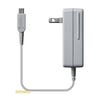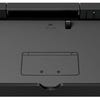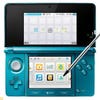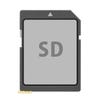European Nintendo 3DS Reviewed
The Eurogamer verdict.
Interface and Options
More so than any previous Nintendo – even DSi – 3DS comes loaded with quirky features. Most are quite disposable, but there's a thoughtfulness and playfulness behind them that make the machine both pleasant and fun to use.
Fire it up and the big, friendly text and calming sonic wallpaper will be instantly familiar to any Wii owner. You're whipped painlessly and quickly through a pointless "3D calibration process" and profile, internet and parental control settings before being asked to press Home.
This new button takes you instantly to the 3DS' Home menu at any point – even during gameplay, since whatever software is running is automatically suspended. (Although 3DS is backwards-compatible with all DS software, old DS games don't support this feature.) The Home menu is similar to the DSi and Wii front-ends, only much better – thanks to the suspension feature, if nothing else. It's all very chunky and colourful in a pleasingly Nintendo way, moving away from the wan neutrality of Wii and DSi.
Here you can browse and organise your software in either a DSi-style strip or iPhone-style grid on the touch screen, accompanied by 3D icons and dioramas above. You can also take notes with the stylus while viewing the paused game screens; check your friends list (at long last, Nintendo is offering proper friends management, where you can add friends to a permanent list using a code or a local connection, and view their online status); and view notifications from Nintendo, from your games and from StreetPass.
StreetPass allows sleeping consoles to exchange data – Mii avatars, say, or game-specifc data – as their users pass in the street. It can be toggled on or off on a per-game basis. Nintendo does love to picture its handheld users enjoying a healthy, active outdoor lifestyle, and another example of this is the cute pedometer which counts the number of steps you take with your 3DS while it's on. Walking earns Play Coins, which can be spent on in-game items in some of Nintendo's software.
Installed Software
Much of the software that comes with 3DS is designed to show off its kitchen-sink range of hardware features, and first of these is the stereoscopic 3D camera, with its two little lenses mounted on the outside of the lid.
Tapping a shoulder button will take you straight to the camera as well as taking pictures once it's fired up. It's not a high-resolution device and it doesn't cope with low light well – or anything less than a foot away from the lens. Taking and showing off 3D snaps is novel enough to get you past the poor image quality, for now.
There's a third, single "inner" camera lens located above the screen that you can use for 2D self-portraits, a wealth of silly photo effects to toy with, a good photo viewer with slideshow, a useful gyroscopic level meter, and for some reason, an animated budgie offering usage tips. The budgie returns with friends in the Sound program, which can be used to play music off the SD card as well record and tweak your own sounds. Pointlessly but charmingly, the budgies imitate anything you say when this program is open.
Mii Maker is a variation of the Wii's avatar creation suite that uses a photograph to define your features once you've selected a few basic parameters for your Mii. You'll want to tweak the result – it turns out that writing facial recognition software is not one of Nintendo's many talents – but it does speed the process along.
StreetPass Mii Plaza, meanwhile, is a diverting home for any Miis you collect from fellow 3DS owners on your travels. It's more interactive than its Wii equivalent; wandering Miis who visit your system will help you complete pictures in Puzzle Swap and can even be used as one-shot heroes to inch you through a basic dungeon crawl called StreetPass Quest. It's a trivial but somehow satisfying reward for harvesting Miis off passers-by.
There are two rather more substantial mini-games pre-loaded onto 3DS. AR Games allows you to play around with augmented reality using the supplied cards. By pointing the twin cameras at a small playing card on a flat surface, you can 'photograph' your Mii or Nintendo mascots standing on your desk, create 3D graffiti to move around the real world (animated cocks, then), or play three short score-attack games.
Shooting involves moving the 3DS (and yourself) around to find and shoot at targets in your room; AR Shot is a sort of virtual miniature golf that warps the real world into moving hillocks to punt a ball around; and Fishing allows you to reel salmon in from your duvet. They all end with a short but imaginative boss battle with a dragon. The novelty value is tremendous, although the combination of a 3D image with augmented reality proves to be a bit too much for both your brain (I had to turn 3D off to cope) and the 3DS (the frame rate frequently drops to single figures), while the games themselves won't keep you interested for more than a few minutes.













